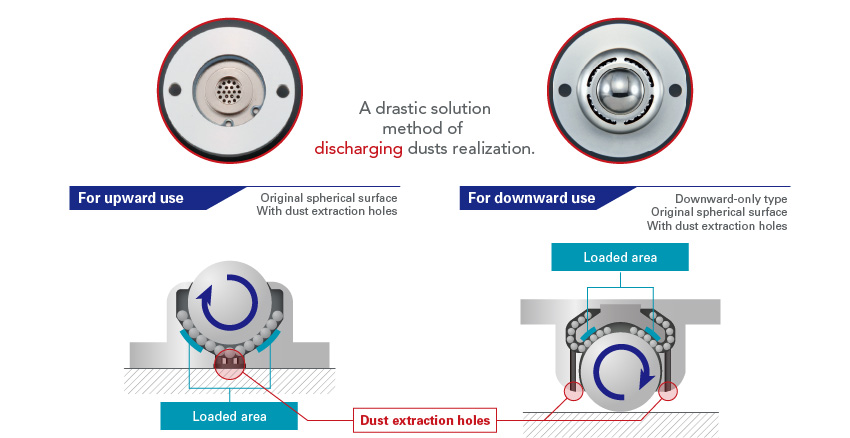The final evolution of the ball transfer
Atec conducted various experiments with respect to the static load rating in the process of transition to the original spherical Planeveyor from conventional spherical one. We got an experimental result which shows that the original spherical has stress on the small balls and ball-receiving portion at a critically low level, compared to a conventional spherical one.
As a result, Atec revised the traditional concept of load notation as "Load capacity", which was provided with the definition of new "Static rated load" and "Load rating". We decided to change the notation.
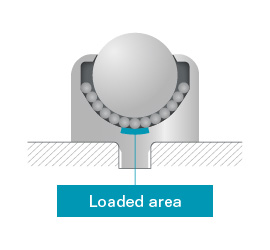
Since the conventional spherical had took a load out with small balls retaking surface directly below the main ball, the number of small balls to distribute the load is with less compression.
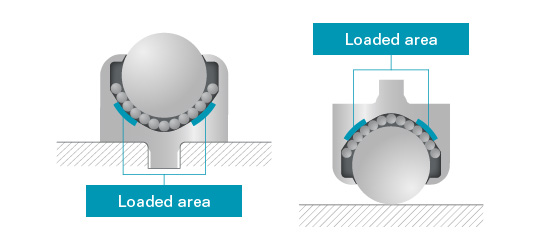
Original spherical surface is the structure where the load is taken by small balls which are placed under the main ball. The small balls form the shape of a circumference and their total number is six times larger than the one in the previous type. Therefore the load has been distributed by small balls which transfer the contact to the main ball.
The displacement (deflection) of the load on the Planeveyor (PV20B) and height (a)*Measurements of Aichi industrial technology Institute
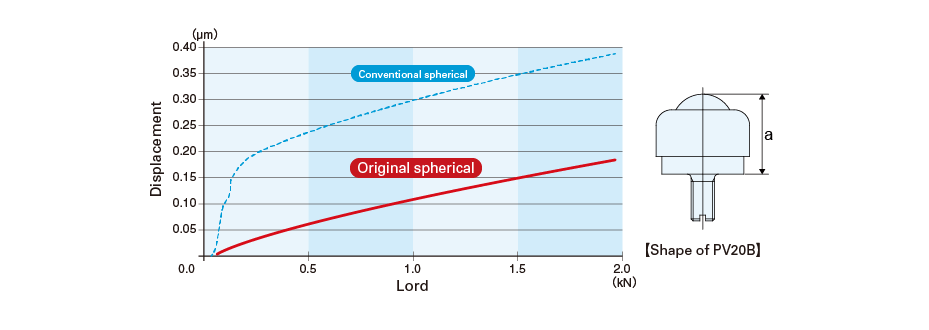
The load on Planeveyor (PV20B) and main and small balls with contact pressure by the spherical surface (by calculation) are shown.
| Lord | 20 kgf | 80 kgf | 100 kgf |
|---|---|---|---|
| Conventional spherical | 3210 MPa | 5090 MPa | 5490 MPa |
| Original spherical | 2540 MPa | 4040 MPa | 4350 MPa |
PLANEVEYOR Definition of Static Rated Load
Static Rated Load is the value set to make the maximum load for Planeveyor when the main ball contact surface is made of SS material and also it can be maintained the startup friction resistance 3/100 or less.
When Planeveyor is used for simple positioning of workpiece etc., please choose static rated load as a guide.
PLANEVEYOR Definition of Load rating
Load rating is the value set to make the maximum load for Planeveyor when the maximum load can be applied to the Planeveyor when the Planeveyor can run 100 km (500 mm / sec) continuously.
When Planeveyor is used for under circumstances that make continuous running, please choose static rated load as a guide.
About recommended load capacity notation
That will use the recommended load capacity derived in consideration for each purpose of use for products use that do not fit the definition above (Static Rated Load · Load rating) with difference in spherical shape, material and structures.
Planeveyor Selection criteria
All of Planeveyor would not be received uniform loads for dimensional tolerances because of Planeveyor body and surface of plane locating. Therefore, please select a Planeveyor as a guide with "weight of the work piece × 1.5 ≦ Planeveyor static load rating (Load rating) × number of Planeveyor on the bottom of the work piece".
For press molded products, please select Planeveyor with "weight of the work piece × 2 ≦ recommended Planeveyor load × number of Planeveyor on the bottom of the work piece" as a guide.
The spring cushion type can be loaded with more Planeveyor if the load greater than the set load is already applied, so Planeveyor can sink and load more. Please select Planeveyor with "weight of the work piece ≤ Planeveyor set load x number of Planeveyor on the bottom of the work piece".
* Please consider the weight of the work piece and decide the thickness of the face to which the Planeveyor will be attached. If the plate thickness is insufficient, the load may be taken only by Planeveyor on the frame, and the part without the frame may not be able to take the load with the plate's rack.
Selection example
- Workpiece’s Weight: 800kg At selection of PV120B(Static rated load) 「800×1.5 ≦ 200×6」
- Workpiece’s Weight: 800kg At selection of PV120B(Static rated load) 「800×1.5 ≦ 120×10」
- Workpiece’s Weight: 500kg At selection of PV30(Recommended use load) 「500×2 ≦ 30×34」
Other recommended usage load, label For products, please use it as a manual to use it with the work described below the indicated load.
Industrial revolution! Atec original spherical surface (PAT.P)
Planeveyor adopts the original spherical surface (PAT.P) of the new mechanism completely different from the ball transfer up to now.
Conventional ball transfer had received the full load of the work piece along with the small ball taking the surface right under the main ball, but Planeveyor adopted the original spherical surface (PAT.P) to load the work piece with a number of small balls It can be received around the circumference.
Rotating of a main ball made by moving a heavy object circulates to the small ball inside, realizing smooth movement, further changing of the material makes it possible to "rust prevent", "heat resistant", "non-magnetic" Function correspondence is also possible.

The only upward / downward dual use of ball transfer in the industry
Even if Planeveyor is used downward due to adoption of the original spherical surface (PAT.P), the load of the work is loaded on the same spherical surface as when using upward facing. Therefore, Planeveyor is the only ball transferer in the industry that can be used regardless of upward facing downward sideways.*There is a downward-only item as a part of high-speed transportation correspondence.
General ball transfer structure
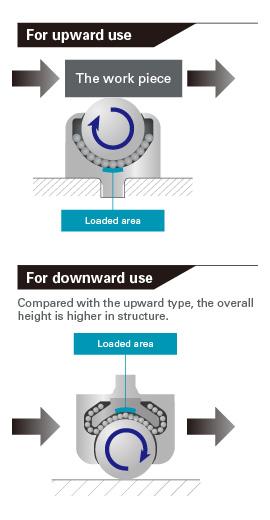
Large durability and smooth rotation can be obtained because many small balls are in contact with the main ball.
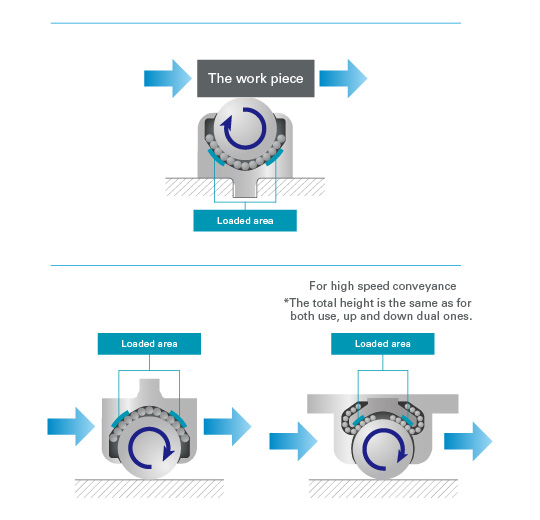
Drastic load capacity and durability performance and adoption improvements of new load notation
When placing the work of the same load, Planeveyor is about 6 times smaller than the conventional product to disperse the load (surface pressure is reduced by about 40%) and the durability has been greatly improved. Regarding the starting frictional resistance, we measured 3/100 or less even in use under the static rated load.*Contact surface with the ball by using SS400 material
In expressing its overwhelming load bearing capability, Planeveyor adopts static rated load and load rating for some load bearings products.Success of lowering prices by realizing COST DOWN
Planeveyor succeeded in reducing the cost greatly by rationalizing the manufacturing process thoroughly and trough mass production of the same kind, due to the characteristics of up and down dual use.
We will continue to provide products that will satisfy all customers by all means in every filed of use.
Can be used under harsh conditions
The Planeveyor does not receive load at the small ball which is receiving surface directly under the main ball. With this structure, a lot of dust punched holes can be opened at the bottom of the main unit. Drill holes in the receiving part of the small ball having difficulties to discharge entering dust and water with conventional structure. Planeveyor dust discharge type continues to operate smoothly even under severe conditions and keeps its smooth rotation.
